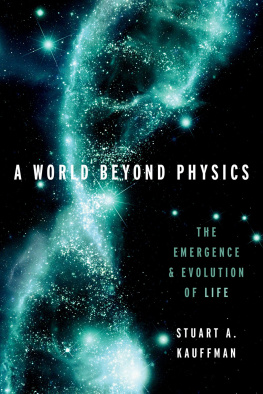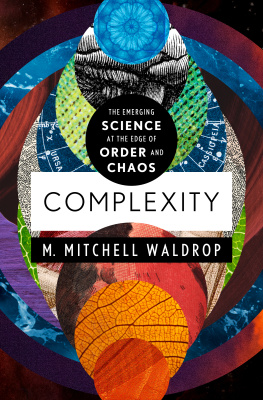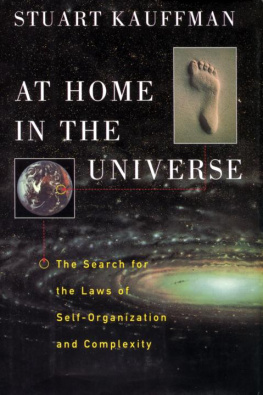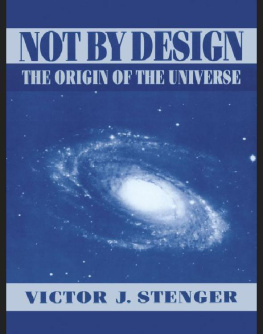AT HOME IN THE UNIVERSE
AT HOME IN THE UNIVERSE
The Search for Laws of Self-Organization and Complexity
Stuart Kauffman

Oxford University Press
Oxford New York
Athens Auckland Bangkok Bombay
Calcutta Cape Town Dar es Salaam Delhi
Florence Hong Kong Istanbul Karachi
Kuala Lumpur Madras Madrid Melbourne
Mexico City Nairobi Paris Singapore
Taipei Tokyo Toronto
and associated companies in
Berlin Ibadan
Copyright 1995 by Stuart Kauffman
First published in 1995 by Oxford University Press, Inc.
198 Madison Avenue, New York, New York 10016
First issued as an Oxford University Press paperback, 1996
Oxford is a registered trademark of Oxford University Press
All rights reserved. No part of this publication may be reproduced,
stored in a retrieval system, or transmitted, in any form or by any means,
electronic, mechanical, photocopying, recording, or otherwise,
without the prior permission of Oxford University Press.
Library of Congress Cataloging-in-Publication Data
Kauffman, Stuart A.
At home in the universe: the search for laws of self-organization
and complexity / Stuart Kauffman.
p. cm. Includes bibliographical references and index.
ISBN-13: 978-019-511130-9
ISBN 0-19-509599-5
ISBN 0-19-511130-3 (Pbk.)
1, LifeOrigin. 2. Self-organizing systems. 3. Molecular
evolution. 4. EvolutionPhilosophy. I. Title.
QH325.K388 1995
577-dc20 94-25268
Dylan Thomas, Poems of Dylan Thomas. Copyright 1967 by the
Trustees for the Copyrights of Dylan Thomas. Reprinted by
permission of New Directions Publishing Corporation.
Figures 3.3, 3.4, 3.7, 4.1, 4.3, 5.1, 5.45.6, 6.1, 8.48.9, 9.1,
10.310.6, and 10.9 from The Origins of Order: Self-Organization
and Selection in Evolution by Stuart A. Kauffman.
Copyright 1993 by Oxford University Press, Inc.
Reprinted by permission of Oxford University Press, Inc.
Figure 5.2 courtesy of Andrew Wuensche.
4 5 6 7 8 9 10 cloth
12 13 14 15 paperback
Printed in the United States of America
on acid-free paper
To my colleagues
at the Santa Fe Institute
and elsewhere,
who, like me,
search for the
laws of complexity.
PREFACE
We live in a world of stunning biological complexity. Molecules of all varieties join in a metabolic dance to make cells. Cells interact with cells to form organisms; organisms interact with organisms to form ecosystems, economies, societies. Where did this grand architecture come from? For more than a century, the only theory that science has offered to explain how this order arose is natural selection. As Darwin taught us, the order of the biological world evolves as natural selection sifts among random mutations for the rare, useful forms. In this view of the history of life, organisms are cobbled-together contraptions wrought by selection, the silent and opportunistic tinkerer. Science has left us as unaccountably improbable accidents against the cold, immense backdrop of space and time.
Thirty years of research have convinced me that this dominant view of biology is incomplete. As I will argue in this book, natural selection is important, but it has not labored alone to craft the fine architectures of the biosphere, from cell to organism to ecosystem. Another sourceself-organizationis the root source of order. The order of the biological world, I have come to believe, is not merely tinkered, but arises naturally and spontaneously because of these principles of self-organizationlaws of complexity that we are just beginning to uncover and understand.
The past three centuries of science have been predominantly reductionist, attempting to break complex systems into simple parts, and those parts, in turn, into simpler parts. The reductionist program has been spectacularly successful, and will continue to be so. But it has often left a vacuum: How do we use the information gleaned about the parts to build up a theory of the whole? The deep difficulty here lies in the fact that the complex whole may exhibit properties that are not readily explained by understanding the parts. The complex whole, in a completely nonmystical sense, can often exhibit collective properties, emergent features that are lawful in their own right.
This book describes my own search for laws of complexity that govern how life arose naturally from a soup of molecules, evolving into the biosphere we see today. Whether we are talking about molecules cooperating to form cells or organisms cooperating to form ecosystems or buyers and sellers cooperating to form markets and economies, we will find grounds to believe that Darwinism is not enough, that natural selection cannot be the sole source of the order we see in the world. In crafting the living world, selection has always acted on systems that exhibit spontaneous order. If I am right, this underlying order, further honed by selection, augurs a new place for usexpected, rather than vastly improbable, at home in the universe in a newly understood way.
Santa Fe, N.M.
October 1994
S. K.
ACKNOWLEDGMENTS
This book could not have been written without the wise editorial crafting of George Johnson, a fine science writer and New York Times editor whose own book, Fire in the Mind: Science, Faith, and the Search for Order, was written even as he was helping me with At Home in the Universe. Early lunches on La Posadas patio in Santa Fe allowed us to lay out the bare bones. I was glad to offer George co-authorship. He refused, feeling that At Home in the Universe should be my book, one minds transect through the emerging sciences of complexity. This was not the last time I took Georges counsel. Every week or two, we would meet at La Posada or hike the high-hill backdrop of Santa Fe, two ranges back from the prairies to avoid Apache raids, and talk through each chapter one by one. In return, I introduced George to the joy of mushroominghe managed to find more lovely boletes than I on our first try. Then it was home to my office to sit in front of the keyboard and, in the standard outpouring of enthusiasm and agony all writers know, spill a chapter onto the electronic page. I would give the result to George, who carved, coaxed, laughed, and hewed. After six such cycles, as I responded each time to his polite demands to cut this, expand that, I was delighted to see a book emerge. The writing is mine, the voice is mine, but the book has a clarity and structure I would not have achieved alone. I am honored to have had Georges help.
CONTENTS
AT HOME IN THE UNIVERSE
Chapter 1
At Home in the Universe
O ut my window, just west of Santa Fe, lies the near spiritual landscape of northern New Mexicobarrancas, mesas, holy lands, the Rio Grandehome to the oldest civilization in North America. So much, so ancient and modern, pregnant with the remote past and the next millennium mingle here, haphazardly, slightly drunk with anticipation. Forty miles away lies Los Alamos, brilliance of mind, brilliance of flashing light that desert dawning in 1945, half a century ago, half our assumptions ago. Just beyond spreads the Valle Grande, remains of an archaic mountain said to have been over 30,000 feet high that blew its top, scattering ash to Arkansas, leaving obsidian for later, finer workings.
Some months ago, I found myself at lunch with Gunter Mahler, a theoretical physicist from Munich visiting the Santa Fe Institute, where a group of colleagues and I are engaged in a search for laws of complexity that would explain the strange patterns that spring up around us. Gunter looked northward, past pion and juniper, taking in the long view toward Colorado, and somewhat astonished me by asking what my image of paradise was. As I groped for an answer, he proposed one: not the high mountains, or the oceans edges, or flat lands. Rather, he suggested, just such terrain as lay before us, long and rolling under strong light, far ranges defining a distant horizon toward which graceful and telling land forms march in fading procession. For reasons I do not completely understand, I felt he was right. We soon fell to speculations about the landscape of East Africa, and wondered whether, in fact, we might conceivably carry some genetic memory of our birthplace, our real Eden, our first home.
Next page






